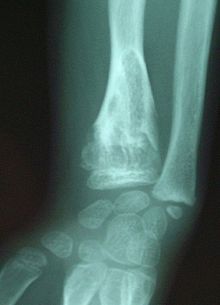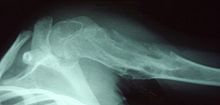- Ollier disease
-
This article is about the disorder. For the French politician, see Patrick Ollier.
Ollier disease Classification and external resources ICD-10 Q78.4 ICD-9 756.4 OMIM 166000 DiseasesDB 9212 eMedicine radio/247 MeSH D004687  X-ray image showing enchondromas localized in the lower part of the radius of a 7-year-old girl with Ollier disease.
X-ray image showing enchondromas localized in the lower part of the radius of a 7-year-old girl with Ollier disease.
Ollier disease is a rare nonhereditary sporadic disorder where intraosseous benign cartilaginous tumors develop close to growth plate cartilage. Prevalence is estimated at around 1 in 100,000.[1]
Contents
Presentation
Nominally, the disease consists of multiple enchondromas which usually develop in childhood. On radiographs, streaks of low density are seen projecting through the diaphyses into the epiphyses of the long bones, due to ectopic cartilage deposits. With age, the cartilage may calcify in the typical "snowflake" pattern. The affected extremity is shortened (asymmetric dwarfism) and sometimes bowed due to epiphyseal fusion anomalies. Persons with Ollier Disease are prone to breaking bones and normally have swollen, aching limbs. One person in every 100,000 is affected. Ollier Disease is not normally diagnosed until toddler years because it is not very visible.
Associated conditions
Ollier Disease carries a high risk of skeletal, visceral and brain malignancy which occurs in approximately 25% of patients. Regular systemic screening is recommended.[2]
Eponyms
The disorder is named after French surgeon Louis Léopold Ollier (1830–1900).[3]
A related disorder called Maffucci syndrome named after Angelo Maffucci is characterized by enchondromas associated with multiple hemangiomas which usually occur in the hands and feet. Maffucci syndrome carries a higher risk for cancer.
References
- ^ Silve C, Jüppner H (2006). "Ollier disease". Orphanet J Rare Dis 1: 37. doi:10.1186/1750-1172-1-37. PMC 1592482. PMID 16995932. http://www.ojrd.com/content/1//37.
- ^ Walid MS, Troup EC (2008). "Cerebellar anaplastic astrocytoma in a teenager with Ollier Disease". J Neurooncol 89 (1): 59–62. doi:10.1007/s11060-008-9583-8. PMID 18414790.
- ^ synd/1813 at Who Named It?
Osteochondrodysplasia (Q77–Q78, 756.4–756.5) Osteodysplasia/
osteodystrophyOther/ungroupedFLNB (Boomerang dysplasia) · Opsismodysplasia · Polyostotic fibrous dysplasia (McCune-Albright syndrome)Chondrodysplasia/
chondrodystrophy
(including dwarfism)enchondromatosis (Ollier disease, Maffucci syndrome)Other dwarfismFibrochondrogenesis · Short rib-polydactyly syndrome (Majewski's polydactyly syndrome) · Léri-Weill dyschondrosteosisCategories:- Skeletal disorders
- Genetic disorders with OMIM but no gene
- Rare diseases
Wikimedia Foundation. 2010.

